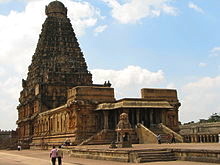Hindu Temple

Religions of the World: Hinduism (1998 Film)
A Mandir is a temple for followers of Hinduism. A characteristic of most temples is the presence of murtis (idols) of the Hindu deity to whom the temple is dedicated. They are usually dedicated to one primary deity, the presiding deity, and other deities associated with the main deity. However, some temples are dedicated to several deities, and others are dedicated to murtis in an iconic form. Many temples are in key geographical points, such as a hill top, near waterfalls, caves and rivers, as these are, according to Hinduism, worship places and make it easier to contemplate God.
Etymology
The Tamil word Koil(Tamil Nadu) or Kovil(Sri Lanka) translates into ‘The King’s House’ (Ko = king il = residence) and is used to refer to a distinct style of Hindu temple with Dravidian architecture.
In Sanskrit, the word mandira means house, palace, temple.
Nomenclature and Orthography
The Brihadeshwara temple, also known as Rajarajeswaram, India’s largest temple and part of the UNESCO World Heritage Site“Great Living Chola Temples.”
The following are the other names by which temple is referred to in India:
- శ్రీ వారిజాల వేణు గోపాల స్వామి దేవస్థానము,Andhra Pradesh,నల్గొండ(జిల్ల),నార్కెట్ పల్లి(మండలం),గోపాలయ పల్లి(గ్రామము),PIN.508254,
- Deul/Doul/Dewaaloy in Assamese
- Mandir (मंदिर) in Nepali, Punjabi, Marathi, Gujarati and Hindi
- Mandiram (మందిరం), Gudi (గుడి), Devalayam (దేవాలయం), Devasthanam (దేవస్థానము),Kovela (కోవెల), Kshetralayam (క్షేత్రాలయం), Punyakshetram(పుణ్యక్షేత్రం), orPunyakshetralayam(పుణ్యక్షేత్రాలయం) in Telugu
- Deval/Raul/Mandir(मंदिर) in Marathi
- Deula (ଦେଉଳ)/Mandira(ମଦିର) in Oriya
- Devasthana (ದೇವಸ್ಥಾನ) in Kannada
- Mondir (মন্দির) in Bengali
- Kshetram (ക്ഷേത്രം), Ambalam (അമ്പലം), or Kovil (കോവിൽ) in Malayalam
- Koil, or kō-ail (கோயில்) and occasionally (especially in modern formal speech) Aalayam(ஆலயம்) in Tamil. The etymology is from kō (கோ) or lord, and il (இல்) home. (Besides meaning a deity’s home, this term could also mean a king‘s home, since the term kō (கோ) is used interchangeably for royalty and divinity)
In Southeast Asia temples known as:
- Candi in Indonesia, especially in Javanese, Malay and Indonesian, used both for Hindu or Buddhist temples.
- Pura in Hindu majority island of Bali, Indonesia.
- Wat in Cambodia and Thailand, also applied to both Hindu and Buddhist temples.
History
The oldest temples, built of brick and wood, no longer exist. Stone later became the preferred material. Temples marked the transition of the Vedic religion to Hinduism. Archaeoastronomy in India provides us with crucial clues to the evolution of the temple and its many cultural functions.
An early description of the temple plan is in the Brihat Samhita of Varahamihira. In the standard square plan, a vastu-purusa-mandala of 64 or 81 squares was first drawn.
Mandir construction and mode of worship is governed by several Sanskrit scriptures called agamas, which deal with individual deities. There are substantial differences in architecture, customs, rituals and traditions in temples in different parts of India. During the consecration of a temple the presence of Brahman is invoked into the main deity of the temple, making the deity and temple sacred.



